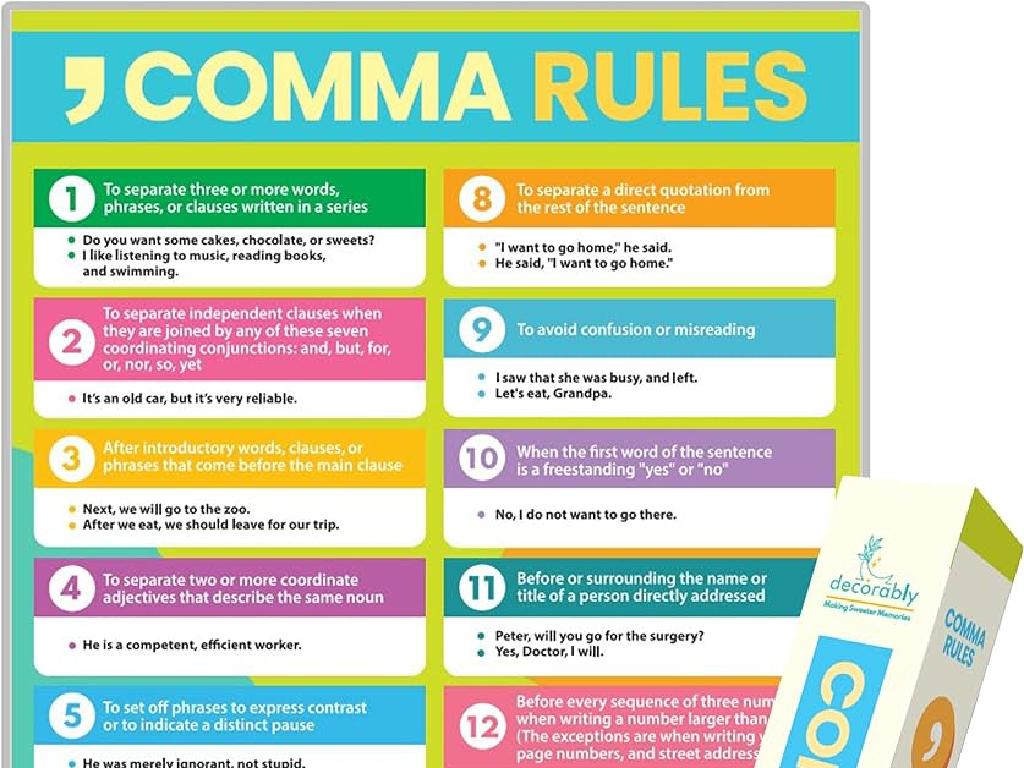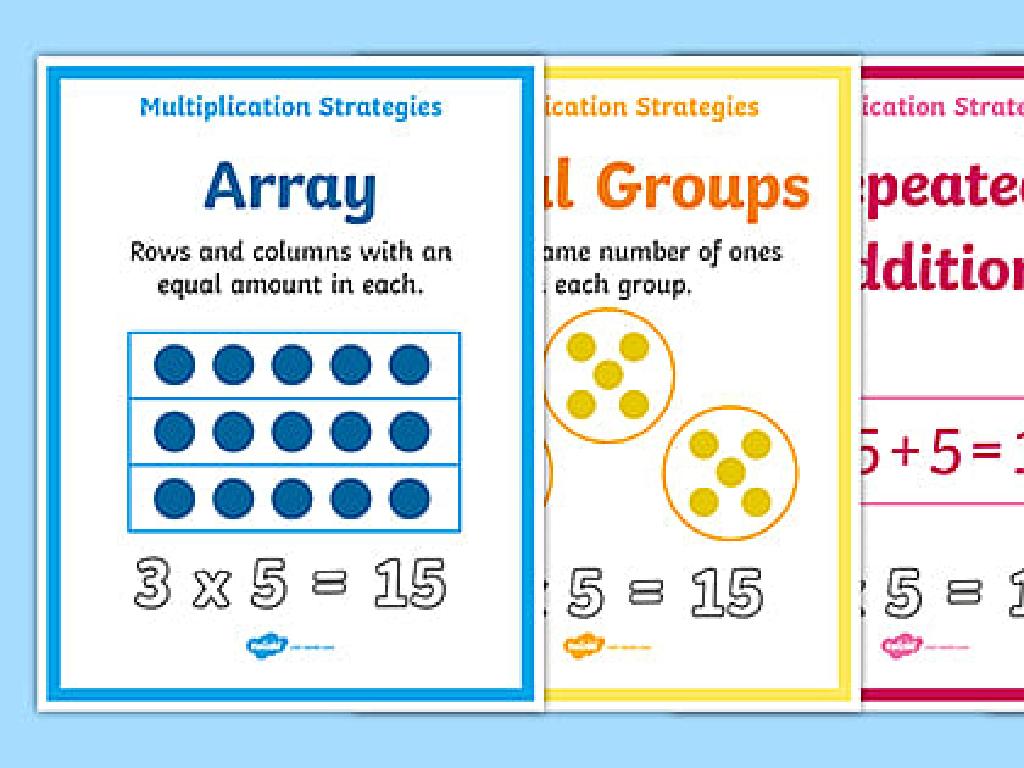Which Two Words Start With The Same Sound?
Subject: Language arts
Grade: Kindergarten
Topic: Beginning And Ending Sounds
Please LOG IN to download the presentation. Access is available to registered users only.
View More Content
Sounds Like Fun: Matching Sounds
– Exploring same starting sounds
– ‘S’ sound in ‘Sun’
– The word ‘Sun’ starts with the ‘S’ sound. What other words start with ‘S’?
– Play a listening game
– Listen carefully to words and find the ones that start with the same sound.
– Find words with ‘S’
– Can you think of other words that start with the sound ‘S’ like ‘Snake’ or ‘Sock’?
|
This slide is designed to introduce Kindergarten students to the concept of phonemic awareness by focusing on the initial sounds of words. Start by explaining that some words start with the same sound and that today’s focus is on the ‘S’ sound. Use the word ‘Sun’ as an example and ask the children to listen for the ‘S’ sound. Engage the class in a listening game where they identify words that start with ‘S’. Encourage them to think of other words that start with the same sound and share them with the class. This activity helps students develop their listening skills and phonemic awareness, which are crucial for reading development.
Learning Sounds: The ‘M’ Sound
– Sounds in words we speak
– Every word has a starting sound
– Practice ‘M’ as in ‘Moon’
– Say ‘Moon’. Hear the ‘mmmm’ sound?
– Find words with the ‘M’ sound
– Can you think of other words that start like ‘Moon’?
|
This slide introduces the concept of sounds in spoken words to Kindergarten students. Begin by explaining that sounds are what we hear when we talk or when someone speaks to us. Emphasize that every word has a sound it starts with, which helps us understand and learn new words. Focus on the ‘M’ sound and use the word ‘Moon’ as an example, encouraging the children to notice the ‘mmmm’ sound at the beginning. Ask the students to practice making the ‘M’ sound themselves. Then, invite them to find and say other words that start with the same ‘M’ sound, such as ‘Mouse’, ‘Milk’, or ‘Mountain’. This activity will help them recognize the ‘M’ sound in different words and is a fundamental step in phonemic awareness and early reading skills.
Matching Sounds: Same Starting Sounds
– Words with similar starting sounds
– ‘Cat’ and ‘Car’ both start with ‘C’
– Think of other ‘C’ starting words
– Examples: ‘Cup’, ‘Cake’, ‘Cap’
– Match pictures with the same sounds
– Use pictures of a cat, car, cup, and cake
|
This slide introduces the concept of phonemic awareness by focusing on the initial sounds of words. Start by explaining that some words have the same starting sound and use ‘Cat’ and ‘Car’ as clear examples. Encourage the children to brainstorm other words that start with the ‘C’ sound, guiding them towards correct answers and praising their efforts. Introduce a matching activity with pictures to reinforce the concept. For the activity, provide various pictures that start with the ‘C’ sound and some that do not, and ask the children to find the ones that match the ‘C’ sound. This interactive approach helps kindergarteners to connect sounds to visual representations, which is crucial for their reading development.
Practice Time: Sound Match Game!
– Listen to the teacher’s word
– Think of a word with the same start
– If the word is ‘Cat’, think of words like ‘Cap’ or ‘Can’
– Find a classmate with a matching sound
– Share your words with the class
– Take turns saying your words aloud
|
This activity is designed to help students recognize and match beginning sounds in words, which is a fundamental skill in phonemic awareness. Start by saying a word clearly and ask the students to find a word that starts with the same sound. Encourage them to think of their word before they start looking for a friend with a matching sound. Once they find their match, they can share their words with the class. This interactive game not only reinforces the concept of beginning sounds but also promotes active listening and cooperation among classmates. Possible words to use: ‘Bat’, ‘Sun’, ‘Fish’, ‘Goat’, ‘Tree’. Make sure to walk around the classroom to assist and guide the students as they engage in the activity.
Let’s Play a Sound Matching Game!
– Look at the pictures I show you
– Tell me the first sound you hear
– Is it ‘ssss’ as in snake, or ‘mmm’ as in monkey?
– Group pictures with the same sound
– Pictures with ‘ssss’ go together, like snake and sun
– Let’s see who finds the most pairs!
– Keep track of your matches to win!
|
This interactive game is designed to help Kindergarten students recognize and match the beginning sounds of words. Display a variety of pictures to the class and ask them to identify the starting sound of each. Encourage them to find and group pictures that share the same starting sound. This activity will not only reinforce their understanding of phonics but also promote active participation and friendly competition. As a teacher, provide guidance and celebrate each correct match to maintain a positive learning environment. Keep the pace lively and ensure every student has a chance to participate.
Story Time: Listening for Sounds
– Listen to ‘Sally Sells Seashells’
– Clap when words sound the same
– Clap every time you hear words that start with the same sound.
– Find matching sounds together
– We’ll discover words with similar starting sounds as a group.
– Practice with ‘S’ sounds
– ‘Sally’ and ‘Seashells’ start with the ‘S’ sound.
|
This slide is for a class activity that will help students recognize and identify words that have the same beginning sound. The teacher will read ‘Sally Sells Seashells by the Seashore’ aloud to the class. Students will listen carefully and clap their hands whenever they hear words that start with the same sound. This interactive activity not only makes learning fun but also enhances the students’ phonemic awareness. It’s important for the teacher to pause after clapping moments to discuss the sounds and words. Possible variations of the activity could include having students stand up instead of clapping, using instruments to make a sound, or having students come up with their own words that start with the ‘S’ sound after the story.
Class Activity: Sound Pairs
– Find objects with matching sounds
– Pair up for sound match
– Find a friend who has an object with the same starting sound as yours
– Share your sound pairs
– Take turns showing the class what you found
– Listen to classmates’ pairs
– Pay attention as others share their sound pairs
|
This activity is designed to help students recognize and match the initial sounds in words, a fundamental skill in phonemic awareness. Have the children walk around the classroom to find objects that start with the same sound. Once they find an object, they should pair up with a classmate who has an object with a matching initial sound. After pairing up, each pair will share their findings with the class. This will not only reinforce their understanding of sounds but also encourage collaboration and listening skills. Possible variations of the activity could include finding objects in a book, matching sounds with flashcards, or even creating a sound-matching game with items from a mystery bag.
Celebrating Sound Similarities
– Congrats on matching sounds!
– Practice listening every day
– Listen to words at home or school
– Ending sounds are up next!
– We’ll discover how words can sound alike at the end
– Keep exploring sounds in words
– Try finding sounds in your favorite stories
|
This slide is meant to congratulate the students on their progress in identifying words with the same starting sounds. It’s important to encourage them to continue practicing this skill in different settings, like at home or in school. Reinforce the idea that practice is key to mastering this concept. Next, we will be moving on to ending sounds, which is an exciting new topic for the students. Encourage them to start thinking about how words can sound similar at the end and to be curious about the sounds they hear in words from their favorite stories or daily conversations. This will prepare them for the next lesson and keep them engaged in learning about phonetics.






